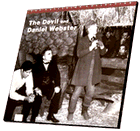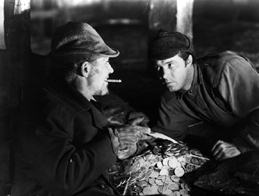

USA comedy
1941
bw 104 min.
Director: Wiliam Dieterle
CLV: $29.95 - taking pre-orders now
1 disc, catalog # CC1243L
VHS: available from Home Vision Cinema

Few films have had as exalted, or as tumultuous, a history as
The Devil and Daniel Webster. Directed and produced by William
Dieterle at RKO after his triumphant Hunchback of Notre Dame,
The Devil and Daniel Webster is the finest of the ambitious
productions that followed in the wake of Citizen Kane. Orson
Welles' movie does, indeed, loom large over The Devil and Daniel
Webster. Kane was released the month before Dieterle's movie
started shooting, and RKO had long been abuzz with talk about what
Welles and his cinematographer Gregg Toland had achieved in cinematic
storytelling. This was, in many respects, the midst of the studio's
Golden Age -- the four year period under George Schaefer, who sought
to elevate the studio's output and had brought Welles to
Hollywood. Among Schaefer's most important actions during this same
period was his decision to back William Dieterle's first independent
production, a screen adaptation of Stephen Vincent Benet's short story
"The Devil and Daniel Webster".Dieterle inherited the services of
several Kane alumni -- editor Robert Wise, composer Bernard
Herrmann, and special effects expert Vernon L. Walker. Already a
veteran director, having made such classics as A Midsummer Night's
Dream, The Story of Louis Pasteur, and Juarez at
Warner Bros., Dieterle was hardly one to take lessons from Orson
Welles. Nor was he anything like the young, daring, and brashly
iconoclastic Welles, although he was very discriminating about his
films. Similarly, cinematographer Joseph August's approach to his work
was also vastly different from that of Gregg Toland.
And, yet, many
parts of The Devil and Daniel Webster play like "Faust Meets
the Mercury Theatre," with dazzling time compressions in the writing
and editing, extraordinarily mobile camera work, and complex shots
involving long, uninterrupted passages of dialogue. The simplest
explanation, and probably the correct one, is that Schaefer and, to a
lesser extent, Welles and Citizen Kane, had fostered an
environment in which this extraordinary film, which broke many rules
in its own right, could be made.
The Devil and Daniel
Webster is resplendent in multiple levels of cinematic beauty:
Dieterle's direction, its dexterousness striking a fine cinematic
counterpoint to the movie's very Germanic mood and subject; August's
chiaroscuro photography, which made every shadow on the screen
memorable; Bernard Herrmann's score, a pastoral wonder that deserved
at least as much recognition as Aaron Copland's Appalachian
Spring; and Robert Wise's editing, which gave The Devil and
Daniel Webster edges as finely cut as those of Kane.
And
then there was the acting: Walter Huston's cheerful, crafty
Mr. Scratch, part-Beelzebub and part-carny show huckster, anticipating
his performance in The Treasure of the Sierra Madre; Simone
Simon's evil, lustful demon-woman, purring kitten-like (and, not
coincidentally, earning herself the title role in Cat People
with this performance) as she seduces an entire village; Edward
Arnold, replacing a gravely injured Thomas Mitchell in the final days
of shooting, dignified but surprisingly passionate as Daniel Webster;
H.B. Warner's sinister Justice Hawthorne, presiding over a jury of the
damned; and Jeff Corey and John Qualen leading a haunting array of
roughhewn New England faces.
Hailed as an instant classic, and
later considered second only to Citizen Kane among all of RKO's
releases, The Devil and Daniel Webster was also one of the most
harshly handled movies of its era. The many titles it has carried
points up its star-crossed history. Previewed as Here Is a Man
on July 16, 1941 at 109 minutes, it opened on October 16, 1941 at 106
minutes as All That Money Can Buy, was later distributed as
The Devil and Daniel Webster, and was reissued in 1952 as
Daniel and the Devil, in a version cut down to 84
minutes.
For the next 38 years -- apart from one print discovered in
Europe, with Danish subtitles burned into it -- the movie was only
known to exist as the 84-minute version. Portions of Bernard
Herrmann's Oscar-winning score were cut and other parts crudely
spliced together, and there was a lot less of both The Devil and
Daniel Webster than one would expect from the title.
Daniel
and the Devil was a neat, compact adaptation of Benet's
story. Missing from it, however, were the moodiest and most
atmospheric portions of the original script, along with all of the
delicately constructed dramatic links between the story's supernatural
elements. Jabez and Mary Stone barely exist as characters in the
84-minute film, while Mr. Scratch's demonic influence is too sketchy,
and Daniel Webster is too far outside of the action. A series of false
sightings of the full-length film during the late 1980s made the
recovery of the original seem an unattainable goal. Then, in 1990, a
full-length Devil and Daniel Webster was located in the form of
a 16mm print that had seen more than its share of action. But it
cleaned up well and looked better than some other recent restorations
from the 1940s, and transferred digitally and retimed, it revealed
more detail than anyone dared hope.
The subsequent reconstruction,
utilizing the finest 35mm fine-grain short version and the 16mm long
print, has given us the first look at the complete The Devil and
Daniel Webster in 50 years. The restored sequences include the
legendary sleigh-ride scene, discussed in absentia for decades by fans
of both the film and Bernard Herrmann's score (a glittering adaptation
of "Miss McLeod Reel"); the detailed seduction of Jabez Stone by
Walter Huston's Mr. Scratch with money and Simone Simon's Belle with
sex; the scenes depicting Stone's deep love of his wife Mary, and his
bitter recriminations as he sinks ever deeper into the debt of the
Devil; the depiction of the bleakness of New England life in the
1840s; and the corruption of Stone's son.
The result is a finer
film, richer in detail, drama and magic, more ominous and more
enchanting, and one that fully and finally lives up to the reputation
it earned in 1941.
-- BRUCE EDER
Credits
Director
and Producer: Wiliam Dieterle
Screenplay: Dan Totheroh, Stephen
Vincent Benet
Original Story: Stephen Vincent
Benet
Cinematography: Joseph August
Editor: Robert
Wise
Music: Bernard Herrmann
Art Direction: Al Herman, Van Nest
Polgase
Special Effects: Linwood Dunn, Vernon L.
Walker
Associate Producer: Charles
L. Glett
Transfer
This restored edition was digitally transferred from both 35mm fine grain and
16mm sources. The soundtrack was mastered digitally from 35mm magnetic
and optical sources.





